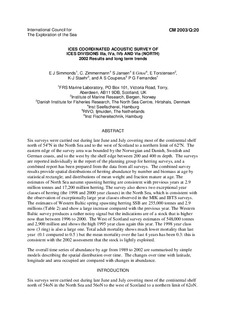| dc.contributor.author | Simmonds, E. John | |
| dc.contributor.author | Zimmermann, Christopher | |
| dc.contributor.author | Jansen, Soenke | |
| dc.contributor.author | Götze, Eberhard | |
| dc.contributor.author | Torstensen, Else | |
| dc.contributor.author | Staehr, K. J. | |
| dc.contributor.author | Couperus, Bram | |
| dc.contributor.author | Fernandes, Paul G. | |
| dc.date.accessioned | 2007-07-12T10:37:24Z | |
| dc.date.issued | 2003 | |
| dc.identifier.uri | http://hdl.handle.net/11250/100593 | |
| dc.description.abstract | Six surveys were carried out during late June and July covering most of the continental shelf
north of 54oN in the North Sea and to the west of Scotland to a northern limit of 62oN. The
eastern edge of the survey area was bounded by the Norwegian and Danish, Swedish and
German coasts, and to the west by the shelf edge between 200 and 400 m depth. The surveys
are reported individually in the report of the planning group for herring surveys, and a
combined report has been prepared from the data from all surveys. The combined survey
results provide spatial distributions of herring abundance by number and biomass at age by
statistical rectangle; and distributions of mean weight and fraction mature at age. The
estimates of North Sea autumn spawning herring are consistent with previous years at 2.9
million tonnes and 17,200 million herring. The survey also shows two exceptional year
classes of herring (the 1998 and 2000 year classes) in the North Sea, which is consistent with
the observation of exceptionally large year classes observed in the MIK and IBTS surveys.
The estimates of Western Baltic spring spawning herring SSB are 255,000 tonnes and 2.9
millions (Table 2) and show a large increase compared with the previous year. The Western
Baltic survey produces a rather noisy signal but the indications are of a stock that is higher
now than between 1996 to 2000. The West of Scotland survey estimates of 548,000 tonnes
and 2,900 million and shows the high 1995 year class again this year. The 1998 year class
now (3 ring) is also a large one. Total adult mortality shows much lower mortality than last
year (0.1 compared to 0.5 ) but the mean mortality over the last 4 years has been 0.3: this is
consistent with the 2002 assessment that the stock is lightly exploited.
The overall time series of abundance by age from 1989 to 2002 are summarised by simple
models describing the spatial distribution over time. The changes over time with latitude,
longitude and area occupied are compared with changes in abundance. | en |
| dc.format.extent | 598982 bytes | |
| dc.format.mimetype | application/pdf | |
| dc.language.iso | eng | en |
| dc.publisher | ICES | en |
| dc.relation.ispartofseries | ICES CM documents | en |
| dc.relation.ispartofseries | 2003/Q:20 | en |
| dc.subject | acoustics | en |
| dc.title | ICES coordinated acoustic survey of ICES divisions IIIa, IVa, IVb AND Via (North) 2002 Results and long term trends | en |
| dc.type | Working paper | en |
| dc.subject.nsi | VDP::Agriculture and fishery disciplines: 900::Fisheries science: 920::Fisheries technology: 924 | |
| dc.source.pagenumber | 23 s. | en |
